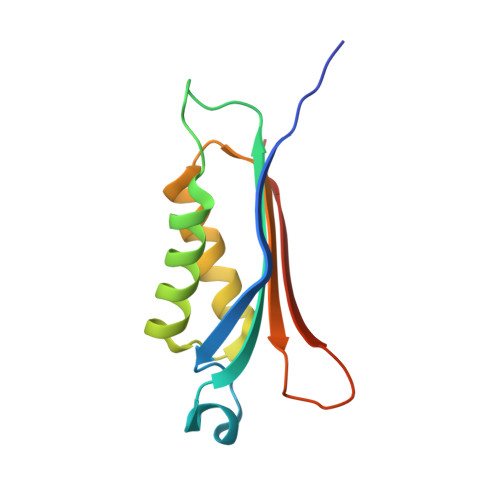Structure of Helicobacter pylori dihydroneopterin aldolase suggests a fragment-based strategy for isozyme-specific inhibitor design.
Shaw, G.X., Fan, L., Cherry, S., Shi, G., Tropea, J.E., Ji, X.(2023) Curr Res Struct Biol 5: 100095-100095
- PubMed: 36820301
- DOI: https://doi.org/10.1016/j.crstbi.2023.100095
- Primary Citation of Related Structures:
8EVK - PubMed Abstract:
Dihydroneopterin aldolase (DHNA) is essential for folate biosynthesis in microorganisms. Without a counterpart in mammals, DHNA is an attractive target for antimicrobial agents. Helicobacter pylori infection occurs in human stomach of over 50% of the world population, but first-line therapies for the infection are facing rapidly increasing resistance. Novel antibiotics are urgently needed, toward which structural information on potential targets is critical. We have determined the crystal structure of H. pylori DHNA (HpDHNA) in complex with a pterin molecule (HpDHNA:Pterin) at 1.49-Å resolution. The HpDHNA:Pterin complex forms a tetramer in crystal. The tetramer is also observed in solution by dynamic light scattering and confirmed by small-angle X-ray scattering. To date, all but one reported DHNA structures are octameric complexes. As the only exception, ligand-free Mycobacterium tuberculosis DHNA (apo-MtDHNA) forms a tetramer in crystal, but its active sites are only partially formed. In contrast, the tetrameric HpDHNA:Pterin complex has well-formed active sites. Each active site accommodates one pterin molecule, but the exit of active site is blocked by two amino acid residues exhibiting a contact distance of 5.2 Å. In contrast, the corresponding contact distance in Staphylococcus aureus DHNA (SaDHNA) is twice the size, ranging from 9.8 to 10.5 Å, for ligand-free enzyme, the substrate complex, the product complex, and an inhibitor complex. This large contact distance indicates that the active site of SaDHNA is wide open. We propose that this isozyme-specific contact distance (ISCD) is a characteristic feature of DHNA active site. Comparative analysis of HpDHNA and SaDHNA structures suggests a fragment-based strategy for the development of isozyme-specific inhibitors.
- Center for Structural Biology, National Cancer Institute, National Institutes of Health, 1050 Boyles Street, Frederick, MD, 21702, USA.
Organizational Affiliation:


















